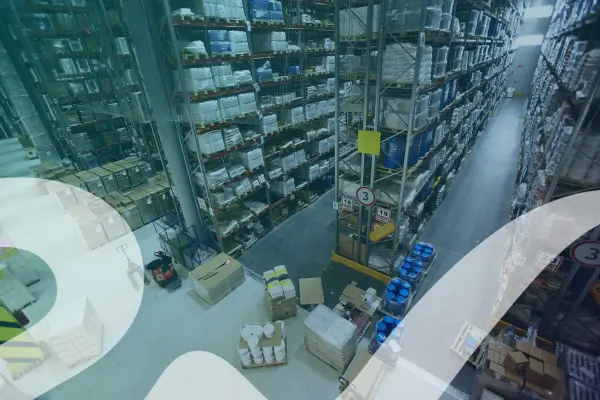Warehouse / intralogistics
Rethinking logistics: How data makes your processes faster, smarter and more efficient
<p>In the field of intralogistics and warehouse logistics, process optimization and increased efficiency play a decisive role in a company’s success. Inefficient processes are identified and improved through the use of data analysis and data engineering, which leads to a significant reduction in operating costs and an increase in overall efficiency. These technologies make it possible to react quickly to changes in the market or in demand and to adapt warehouse strategies flexibly and dynamically. </p>
<p>Our expertise in data analytics and data engineering helps companies implement more efficient warehouse processes. By developing and implementing tailored solutions such as advanced data analytics models, real-time monitoring systems and predictive analytics tools, we help to optimize warehouse performance, increase employee performance and improve adaptability to market dynamics. This leads to improved warehouse management, cost savings and a stronger competitive position. </p>
<h2>Process optimization and increased efficiency</h2>
<h6>Use of data analysis to identify and implement more efficient warehouse processes:</h6>
<ul>
<li><strong>Increasing overall efficiency</strong>: By optimizing the warehouse layout and picking processes, travel times can be minimized and accessibility improved. This leads to faster processing of warehouse tasks and more efficient goods handling. </li>
<li><strong>Reducing operating costs</strong>: Identifying and eliminating bottlenecks and optimizing employee performance helps to eliminate unnecessary delays and inefficiencies. This results in a reduction in costs while maintaining high quality standards. </li>
<li><strong>Improving adaptability</strong>: By using real-time analyses and predictive analysis methods, companies can react quickly to changes in the market or in demand. This enables flexible and dynamic adaptation of warehouse strategies in order to increase competitiveness. </li>
</ul>
<p>Concrete measures and services:</p>
<ul>
<li><strong>Optimization of warehouse layout through advanced data analysis</strong>: Use of data engineering and machine learning to analyse movement data and usage patterns in the warehouse. The aim is to identify inefficient use of space and redesign the layout to minimize travel times and improve accessibility. This leads to increased efficiency in order picking and optimized goods handling. </li>
<li><strong>Picking optimization through data analysis</strong>: Use of data engineering to analyse picking times and routes with the aim of increasing picking efficiency through intelligent route planning and order composition. This enables dynamic adaptation of strategies in real time to further improve performance. </li>
<li><strong>Bottleneck identification with predictive analytics</strong>: Use advanced data analytics to identify bottlenecks in real time and suggest preventative measures to avoid future disruptions. Through predictive insights, resources can be allocated in a targeted manner to maximize efficiency. </li>
<li><strong>Employee performance monitoring through data integration</strong>: Using data engineering to collect and analyze performance data to develop optimization opportunities. This leads to increased productivity and optimized process execution. </li>
<li><strong>Item placement optimization using machine learning</strong>: Use algorithms to analyse sales and movement data to determine the optimal placement of items in the warehouse and maximize turnover. This strategic placement speeds up access and increases the efficiency of the flow of goods. </li>
<li><strong>Throughput time reduction through real-time analysis</strong>: Implementation of data engineering solutions to monitor and analyze throughput times in order to identify and implement process improvements that lead to faster processes. This leads to tighter process management and a faster response to market changes. </li>
</ul>
<p> </p>
<h2>Inventory management and predictive analytics:</h2>
<h6>Use of data-driven forecasting models to optimize inventory levels:</h6>
<ul>
<li><strong>Increased cost efficiency</strong>: Precise inventory forecasting models and the automation of ordering processes reduce overstocks and stock-outs, enabling direct savings on inventory costs and reducing the need for expensive rush orders.</li>
<li><strong>Improving customer satisfaction</strong>: The ability to manage inventory precisely according to demand ensures greater availability of the desired products and reduces waiting times for customers, which strengthens customer satisfaction and loyalty.</li>
<li><strong>Increased operational efficiency</strong>: Real-time inventory control and dynamic adjustments in response to changes in demand optimize warehouse operations, improve response speed and minimize the risk of stockouts or overstocking.</li>
</ul>
<p><strong>Concrete measures and services:</strong></p>
<ul>
<li><strong>Development of accurate inventory forecasting models</strong>: Creation of customized forecasting models based on specific customer data. These models enable accurate prediction of future stock requirements, reduce overstocking and avoid stockouts, resulting in cost savings and increased customer satisfaction. </li>
<li><strong>Dynamic demand forecasting</strong>: Implementation of advanced algorithms to analyze sales histories and market trends. The resulting insights enable precise adjustment of stock levels to demand, which leads to optimized warehousing and a reduction in unnecessary storage costs. </li>
<li><strong>Real-time inventory control and monitoring</strong>: Continuous monitoring of stock levels using real-time data analysis. This improves inventory accuracy and enables immediate adjustments to unexpected changes in demand, increasing efficiency in warehouse operations and minimizing the risk of stock-outs. </li>
<li><strong>Automated order process planning</strong>: Using data engineering to automate order processes to enable more efficient reordering based on current inventory data and demand forecasts. This leads to tighter inventory management and reduces the costs associated with over-ordering. </li>
</ul>
<p> </p>
<h2>Digitization and real-time monitoring:</h2>
<h6>Improvement of warehouse management and process control through the use of real-time data acquisition and analysis:</h6>
<ul>
<li><strong>Increased productivity and efficiency</strong>: Real-time monitoring of picking performance enables precise performance evaluation and rapid adjustment of work processes, which increases the throughput speed of orders and boosts productivity.</li>
<li><strong>Optimization of processes</strong>: By analyzing movement data and warehouse processes in real time, inefficiencies can be identified and rectified promptly, resulting in continuous improvement of warehouse operations.</li>
<li><strong>Improve workforce planning and employee motivation</strong>: Transparent, real-time performance monitoring not only supports workforce planning through data-driven insights, but also boosts employee motivation through instant feedback and recognition, ultimately improving overall efficiency and employee satisfaction.</li>
</ul>
<p><strong>Concrete measures and services:</strong></p>
<ul>
<li><strong>Real-time picking monitoring</strong>: Real-time monitoring of picking performance, which enables individual performance data per employee and customer to be recorded and analyzed. This improves personnel planning and increases productivity through targeted optimization. </li>
<li><strong>Movement data analysis for picking optimization</strong>: Implementation of analysis tools that record movement data in the warehouse in order to optimize picking routes. Customers benefit from shorter picking times and increased order throughput speed. </li>
<li><strong>Real-time process optimization analysis</strong>: Use advanced data analytics to identify inefficiencies in warehouse processes and enable process improvement solutions. This leads to a continuous improvement of warehouse operations and a reduction in operating costs. </li>
<li><strong>Real-time performance monitoring for warehouse employees</strong>: Development and implementation of tools to monitor the performance of warehouse employees in real time, making the efficiency and productivity of each employee transparent. This enables immediate recognition of individual performance and rapid adjustment of work processes, which can directly increase operational efficiency and employee motivation. </li>
</ul>
<p> </p>
<h3>Quality management and strategic planning:</h3>
<h6>Use of data analysis to ensure product quality and support long-term storage strategies:</h6>
<ul>
<li><strong>Improved decision making</strong>: Automated reporting and KPI dashboards provide a clear view of performance indicators, enable rapid response to change and support data-driven decision making.</li>
<li><strong>Supply optimization</strong>: Customer behavior analysis helps to better understand demand and effectively adjust inventory levels and product placement, minimizing overstocking and increasing customer satisfaction.</li>
<li><strong>Strategic advantages</strong>: Strategic planning with the help of trend analyses improves the long-term alignment and utilization of resources, which leads to a sustainable increase in efficiency and cost reduction.</li>
</ul>
<p><strong>Concrete measures and services:</strong></p>
<ul>
<li><strong>Automated reporting and KPI dashboards</strong>: Providing automated reports and KPI dashboards enables faster decision making and a transparent performance overview. Customers can continuously monitor their processes and optimize them in a timely manner if necessary. </li>
<li><strong>Customer behaviour analysis for stock optimization</strong>: Performing analyses of customer behaviour to optimize stock levels and product placement. This allows supply to be precisely matched to demand, reducing excess stock and increasing customer satisfaction. </li>
<li><strong>Strategic warehouse planning through trend analyses</strong>: Creation of trend analyses and forecasting models to support long-term warehouse strategies and capacity planning. Customers benefit from improved planning reliability and can deploy their resources more effectively. </li>
<li><strong>Cost reduction through detailed cost analysis</strong>: In-depth analysis of storage costs to uncover potential savings. This leads to a significant reduction in costs and more efficient warehousing. </li>
</ul>
<p> </p>
<h3>Why logistics companies should rely on data-based solutions</h3>
<p>The use of intelligent data solutions brings numerous benefits to the logistics sector:</p>
<p>✅ Greater efficiency: faster processes, optimized stocks and reduced delivery times.</p>
<p>✅ Cost savings: fewer empty runs, lower storage costs and more precise demand planning.</p>
<p>✅ More transparency: real-time insights into warehouse and transport processes for better decisions.</p>
<p>✅ Sustainability: Lower resource consumption and reduction of CO₂ emissions. Use the power of data to make your logistics processes smarter, more efficient and more sustainable! </p>





